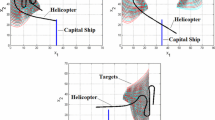Abstract
This paper presents a single numerical performance characteristic for the evaluation of seeker tracking algorithms. It concentrates on ship IR seeker tracking algorithms. Assessing the threat from guided missiles needs a sound evaluation of their performance. The main goal is to introduce a characteristic which is able to assess the threat for ships depending on various scenario parameters. It is shown that for these applications such a single characteristic is sufficient. In order to achieve this five popular tracking algorithms are used. Synthetic IR image sequences are generated to simulate a large set of attack approaches and assemble sufficient statistics on the behavior of the algorithms. The introduced characteristic can also be used for investigations on algorithms themselves, e.g. for sensitivity analyses and parameter optimization of a single algorithm, and for comparison of different algorithms.
Similar content being viewed by others
References
D. R. Anderson, J. Moore, J. Montgomery, and M. Chambliss, “Infrared seeker performance metrics,” SBIR A02-158: Phase I SBIR, Final Report (2003). http://www.dtic.mil/cgi-bin/GetTR-Doc?AD=ADA419746
K. Bernardin and R. Stiefelhagen, “Evaluating multiple object tracking performance: the CLEAR MOT metrics,” EURASIP J. Image Video Processing 2008, 1–10 (2008).
L. Doktorski, E. Michaelsen, and E. Repasi, “A single performance characteristic for the evaluation of seeker tracking algorithms,” in Proc. IMTA-4 2013 Image Mining. Theory and Applications, Ed. by I. Gurevich, O. Salvetti, and H. Niemann (Scitepress, 2013), pp. 3–13.
K. K. Edward, P. D. Matthew, and B. H. Michael, “An information theoretic approach for tracker performance evaluation,” in Proc. 12th IEEE Int. Conf. on Computer Vision (Kyoto, 2009), pp. 1523–1529.
H. Gerlach, Digitale Bildfolgenauswertung zum Wiederfinden von Objekten in naturlicher Umgebung (FGAN-FIM, Karlsruhe, 1979).
R. D. Hudson, Jr., Infrared System Engineering (John Wiley & Sons, New York, 1969).
W. de Jong, F. A. Dam, G. J. Kunz, and R. M. A. Schleijpen, “IR seeker simulator and IR scene generation to evaluate IR decoy effectiveness,” Proc. SPIE 5615, 100–111 (2004).
W. de Jong, S. P. van den Broek, and R. van der Nol, “IR seeker simulator to evaluate IR decoy effectiveness,” Proc. SPIE 4718, 164–172 (2002).
P. D. Lavailee, J. A. Lightfoot, M. A. Chambliss, C. Kimbel, and J. R. Griffin, “Methodology for evaluating autonomous IR tracker performance,” in Proc. Ground Targets Modeling and Validation Conf. (Houghton, MI, 2002).
R. Legault, The Infrared Handbook, Chap. 17: Reticle and Image Analyses, Ed. by W. L. Wolfe and G. J. Zissis (Office of Naval Research, Department of the Navy, Washington, 1989).
Y. Li and J. Yan, “Performance evaluation of imaging seeker tracking algorithm based on multi-features,” in Proc. Int. Symp. on Photoelectronic Detection and Imaging 2011: Advances in Infrared Imaging and Applications, Ed. by J. J. Puschell, J. Chu, H. Gong, and J. Lu; Proc. SPIE 8193, 81932A–81932A-7 (2011).
R. E. Nasburg, Electro-Optical Systems Design, Analysis, and Testing, Chap. 5: Tracking and Control Systems, Ed. by M. C. Dudznik, Ed. (Infrared Information Analysis Center, Environmental Research Institute of Michigan, Ann Harbor, 1993).
C. J. Needham and D. Boyle, “Performance evaluation metrics and statistics for positional tracker evaluation,” in Proc. 3rd Int. Conf. on Computer Vision Systems ICVS 2003 (Toulouse, 2003), Vol. 2626, pp. 278–289.
R. H. M. A. Schleijpen, “Toolset for evaluating infrared countermeasures and signature reduction for ships,” Proc. SPIE 7836 (2010).
R. H. M. A. Schleijpen, “Evaluation of infrared-signature suppression of ships,” Proc. SPIE 2742, 245–254 1996.
R. Schoemaker and R. Schleijpen, “Evaluation tools for the effectiveness of infrared countermeasures and signature reduction for ships,” Proc. SPIE 7662 (2010).
K. Suzuki, “Analysis of rising-sun reticle,” Opt. Eng. 18(3), 350–351 (1979).
D. A. Vaitekunas, “IR susceptibility of naval ships using ShipIR/NTCS,” Proc. SPIE 7662 (2010).
Author information
Authors and Affiliations
Corresponding author
Additional information
The article is published in the original.
This article uses the materials of the report submitted at the 4th International Workshop “Image Mining. Theory and Applications”, Barcelona, Spain, February 2013.
Leo Doktorski. Born 1952. Received diploma in Mathematics from the Rostov-on-Don State University in 1974 and Dr. rer. nat. (Kandidat Nauk) degree also from the Rostov-on-Don State University in 1978. He works as researcher in the IOSB-Fraunhofer in Ettlingen, Germany. He has published more than 50 papers in various journals, conferences and workshops.
Eckart Michaelsen graduated from University of Innsbruck (Austria) in 1987 with diploma on Mathematics. He started working for Forschungsinstitut fur Mustererkennung, Forschungsgesellschaft fur angewandte Naturwissenschaften (FIM-FGAN) in Ettlingen (Germany) the same year, and stays with this affiliation since now. Today this lab is integrated in the IOSB (Institut fur Optronik, Systemtechnik und Bildauswertung) of the Fraunhofer Gesellschaft. In 1998 Eckart Michaelsen received Dr.-Ing. from the University of Erlangen (chair for pattern recognition H. Niemann), working on syntactic methods of pattern recognition. He is co-chair of IAPR-TC7 (pattern recognition in remote sensing), associate editor of Pattern Recognition Letters, and member of IEEE and DAGM.
Endre Repasi. Born in 1952. Received diploma in Electrical Engineering from the University of Karlsruhe, Germany in 1979. He is with the Fraunhofer IOSB in Ettlingen, Germany as senior scientists. He is working in the field of sensor modeling and imaging simulations for the performance assessment of active and passive EO-systems.
Rights and permissions
About this article
Cite this article
Doktorski, L., Michaelsen, E. & Repasi, E. A single performance characteristic for the evaluation of seeker tracking algorithms. Pattern Recognit. Image Anal. 24, 218–225 (2014). https://doi.org/10.1134/S1054661814020047
Received:
Published:
Issue Date:
DOI: https://doi.org/10.1134/S1054661814020047




